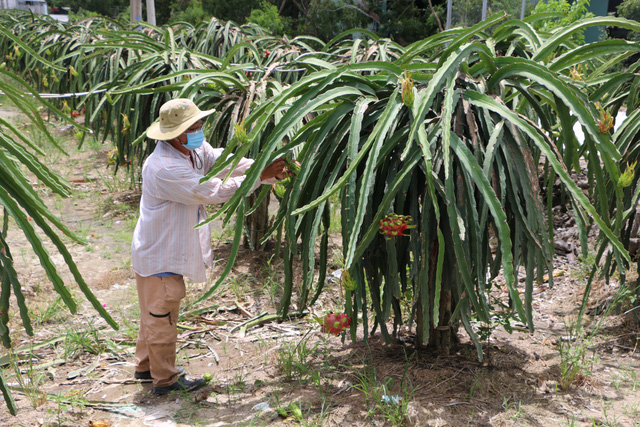Agricultures, Foods, News & Event
Fruits Are In Season, Depreciate: The paradox of Vietnamese agricultural products
Finding Outputs for Fruits in the Mekong Delta

Currently the fruit is in the main harvest, so the supply to the market is increasing. According to the Department of Crop Production, Ministry of Agriculture and Rural Development, about 1.2 million tons of fruit need to be consumed in the second quarter of this year, mainly in the South. Off-season fruits also account for more than 50% of the output, but most of them are showing signs of repeating the chorus of “good harvest, low price”.
Specifically, at this time every year, the price of avocado is 25,000 VND/kg, now it is only 18,000 – 20,000 VND/kg. Red flesh dragon fruit in Tien Giang decreased to 14,000 VND/kg, white flesh dragon fruit decreased to 9,000 VND/kg. Watermelon reduced to 7,000 VND/kg…
With 0.5 hectares of land, Mr. Sang (Tan Khanh Trung commune, Lap Vo, Dong Thap) harvested about 15 tons of mangoes. Buoyant but he is still not happy. 1 kg of Cat Chu mango, traders buy 5,000 VND. Public care, manure and medicine are considered as capital loss. The price of specialty mangoes is the same, less delicious like Taiwanese mangoes, the price is only 2,000 VND/kg.
“Mango is so cheap now, anchored forever. The more anchored, the more dead”, Mr. Vo Thanh Sang, Tan Khanh Trung commune, Lap Vo, Dong Thap, shared.
The Mekong Delta has about 307,000 hectares of fruit trees. Currently the selling price is quite low. Like mango, the price is from 2,000 to 6,000 VND/kg depending on the type. Jackfruit and dragon fruit are also much lower compared to other years. Depressed, some Taiwanese dragon fruit and mango farmers decided to cut down their gardens.
“The pole has no profit. So I broke it down and found another tree to plant to have an income to support my family,” said Mai Van Be Tu, Trung Hoa commune, Cho Gao, Tien Giang.
According to businesses, the low price of various fruits in the Mekong Delta is due to difficulties in exporting to China. To remove it, localities have connected with traders in Ho Chi Minh City and Hanoi for domestic consumption.
On the other hand, localities also cooperate with enterprises to create local raw material areas, both to export fresh products and to undergo intensive processing.
This is the long-term direction. In the immediate future, fruit growers are facing many difficulties when prices are volatile. Farmers continued with the chorus of planting and chopping.
Fruit exports fell in the first 4 months of the year
According to the Vietnam Fruit and Vegetable Processing Association, the second quarter is the time when eight main types of fruit trees in the South will be harvested, including: dragon fruit, banana, mango, jackfruit, grapefruit, orange, pineapple, and durian. In which, the Mekong Delta alone is more than 940,000 tons, but the market continued to decline in the last week of April to the beginning of May.
In addition to the high supply and falling prices, also because China – Vietnam’s main fruit import market continues to implement the Zero COVID-19 policy, making it difficult to export to this key market. towel.
The ongoing war between Russia and Ukraine causes transportation costs to rise, due to the need to change routes or transport routes through more transit stages. The export value of Vietnamese fruits and vegetables in the first four months of this year reached more than 1.1 billion USD, down more than 15% over the same period. China is still the largest market with more than 53% market share, followed by the US, Korea, and Japan.
Adapt flexibly when supply exceeds demand
Facing difficulties in fruit consumption as in the past time, some localities have also had alternative solutions while waiting for customs clearance to return to normal. As in Binh Thuan province, from the beginning of the year until now, the area of dragon fruit in this province has decreased by more than 900 hectares.
While many households quickly cut down dragon fruit because of falling prices, some households learned to adapt flexibly to survive through difficult times, trusting to wait for the market to prosper again.
With 9 hectares of dragon fruit, after 5 seasons of off-season lighting, losing more than 1 billion dong, this farm has learned to reduce some input costs but still ensure production and sell products. market, limiting economic losses.
There are 2,200 dragon fruit pillars, thanks to the application of 3 reduction measures: reducing labor hire; reducing fertilizer investment and reducing off-season handling, so Mr. Triem (Thuan Quy commune, Ham Thuan Nam, Binh Thuan) has avoided losses. The flexible management during the time when dragon fruit prices fell deeply was encouraged by local authorities to replicate.
Thuan Quy commune does not have an area of destroyed dragon fruit. Currently, the locality still maintains production of 580 hectares of dragon fruit, of which nearly 90% is cultivated according to VietGAP standards. This is also the leading locality in Binh Thuan province in good implementation of VietGAP dragon fruit production for export.
According to the General Department of Customs, currently the clearance speed at the border gates of Lang Son province is about 140 vehicles a day. Lang Son still has about 700 cars waiting to be exported, of which 461 cars are for fruit alone. If the export situation of fresh fruit does not improve and still runs around worrying about consuming in the domestic market, the price is unpredictable.
Therefore, the Department of Crop Production recommends that localities need to support to promote production linkages associated with the output of products, so that entrepreneurs can design modern production areas according to professional techniques and agricultural products. Only high value has stable output.
Source: http://agro.gov.vn/vn/tID31115_Trai-cay-duoc-mua-mat-gia.html

